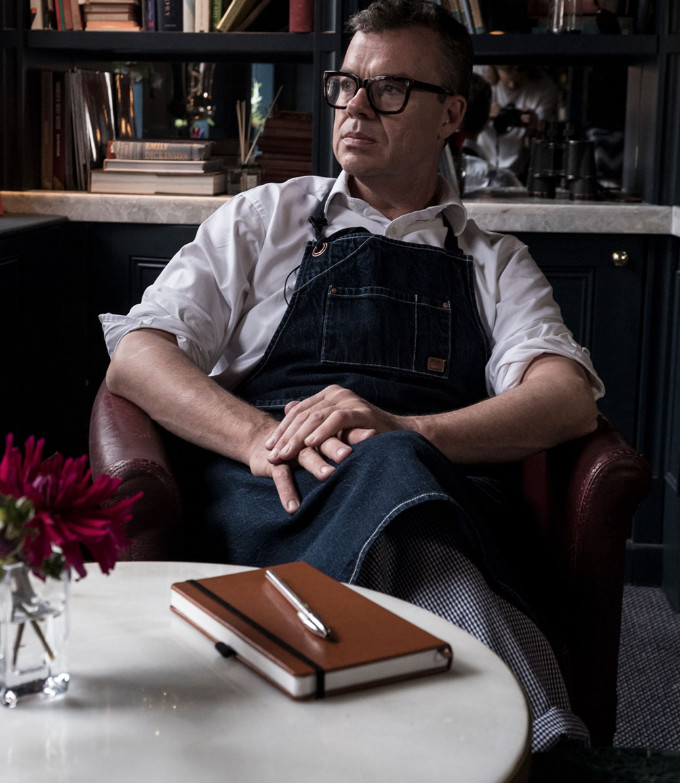What is a dish you grew up with?
I grew up in the UK but my parents are Indian in heritage and we would travel back and forth from India. So I ate a lot of Indian food growing up, like a hell of a lot of it, maybe four or five days a week.
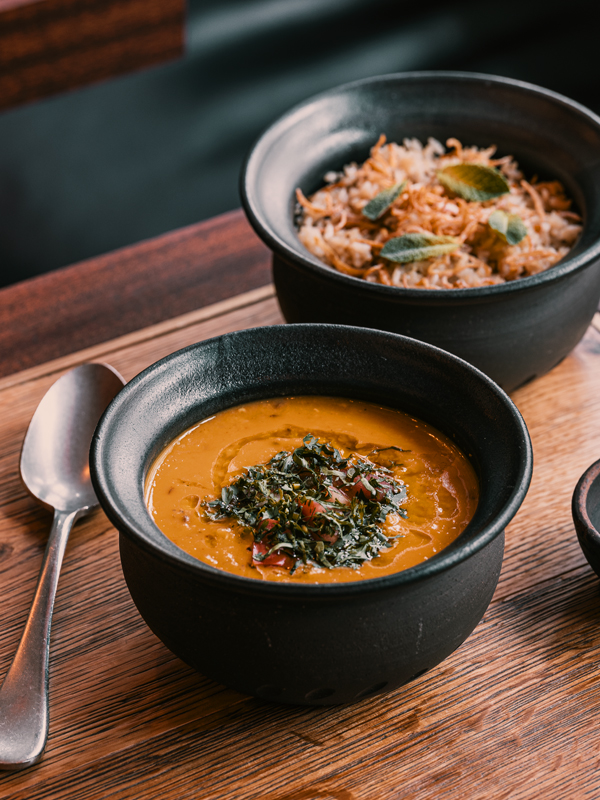 Both my parents were vegetarian, and still are, so I was brought up pretty much vegetarian until I was around 14 or 15. We’d eat a lot of vegetables and lentils for protein. A meal wouldn’t be complete unless it had lentils, flatbreads and at least one vegetable dish, such as a curry or stir fry. When I say stir fry I mean a dry fried spiced dish, which is called sabji in the north of India.
Both my parents were vegetarian, and still are, so I was brought up pretty much vegetarian until I was around 14 or 15. We’d eat a lot of vegetables and lentils for protein. A meal wouldn’t be complete unless it had lentils, flatbreads and at least one vegetable dish, such as a curry or stir fry. When I say stir fry I mean a dry fried spiced dish, which is called sabji in the north of India.
My Bibis, which is what I call my grandmothers, and who I named my restaurant after, were both amazing cooks. We lived with my dad’s mum until I was about ten, when she decided to spread her wings and move into an apartment down the road from us. She was the main cook of the house and she was amazing at it, and very passionate. Having grown up on a farm, she brought with her a philosophy of growing her own vegetables, making her own yogurts and pickles. That was all very much a part of growing up in our household.
My parents and their families had very different upbringings. My mom’s dad was born in Lahore, which is the capital of the Punjab region and now part of Pakistan. So he was 14 years old when India and Pakistan were split up into two separate countries. But my dad’s family were from the other side of Punjab, and when we say the other side, Punjab is bigger than the UK, so whilst they were the same religion they spoke a different language.
Both my father and his father were actually born in Kenya after their family moved there at the beginning of the 20th century. Interestingly a lot of Indians under the British Empire had moved to Kenya during that period. Typically they were civil servants, working for the post office, involved in building the railway, “the educated class”. Or they were business people like my family were.
We had a wooden toy making company in Kenya, and eventually got into the insurance business, so our family was well established in Nairobi, where we had a large house and compound. My father’s mum would get a lot of influence from the people working in the house, who were typically from Maasai Maran, so lots of local vegetables and ingredients. But also, because Indians move in enclaves, my grandmother, who was from a tiny village in Punjab and had never been out of the state before moving to Kenya, was exposed to all these people from different regions of India. From Gujarat, from Rajustan, from Hayrian, and all the other big states.
“At our restaurant now, as part of your main course, you will always get rice, roti and dhal. That dhal is my grandmother’s Tuesday night dhal.”
Different cuisines would find their way into our household. For example, we would eat something called Handvo, which I just presumed was a Punjabi dish until I met other people from the Punjab who weren’t East African and realised it was actually from Gujarat. The same with Dhokla, which is a dish that made it onto our restaurant menu.
Dhokla is a gram flour savory sponge cake that my mum got introduced to for the first time in London, through my dad’s mother. Despite having lived in Delhi and Mumbai and zipped around a lot of India, it’s a dish that had previously eluded her. That says a lot about how little food travels between states and regions within India. She now loves to cook it and will often bring some to my house.
One day I came back from a long shift at work and there was some Dhokla in the fridge, as well as some tuna mayo my wife had left over and an avocado. I mixed the three together and it was delicious. So when I opened Bibi it was a dish I wanted to develop.
In terms of flavor, the aim is to get the lightest sponge you’ve ever had. We start with a yogurt base, then add black chickpea flour and leave that to ferment for a little while. Then the hack is to add fruit salt rather than sodium bicarbonate. It’s an ingredient that came from the British Empire and was used as a digestive but works really well at aerating sponges without that alkaline bitterness you get with bicarb.
You then put in a tempering of asafoetida, cooked out in vegetable oil, along with a little ginger and turmeric, which helps balance it out, making it a little bit more savory and giving it that umami roundness. You mix that all together, working very quickly, because as soon as you put the fruit salt in it starts going crazy and bubbles all over the place. That mix goes into a lined loaf tin and is steamed for 15-20 minutes.
I actually quite like it plain because that’s how we used to eat it at home, but the fancier way of doing it is to fry mustard seeds, curry leaves, a little bit of coconut and red chilli, letting that down with a little coconut water, then you soak the entire sponge with that mix while it’s screaming hot. As there is no fat in the batter, that coconut tempering helps to get the sponge squidgy and soft.
What we’ve done at Bibi in the past is put diced lobster through the mix and added lobster shell mayo on top. It’s a delicious and decadent dish that has ultimately ended up on the menu through the movement of people in India and the different exposures my family has had to regional cooking.
Another Punjabi dish that is big part of Bibi’s offering is our dhal, which we serve as part of the main course. That dhal is my grandmother’s Tuesday night dhal. It’s a dish I grew up eating, and it’s so simple, so clean. There’s no cream, no butter, there’s no messing around with it. It’s a dish we eat after service too, because it’s light, nutritious and in my opinion, very tasty. It’s actually one of the very few things on the menu that we’ve not changed. It has one spice and asafoetida in the tempering and that’s it. It shows what Indian food can be if you treat it with respect.
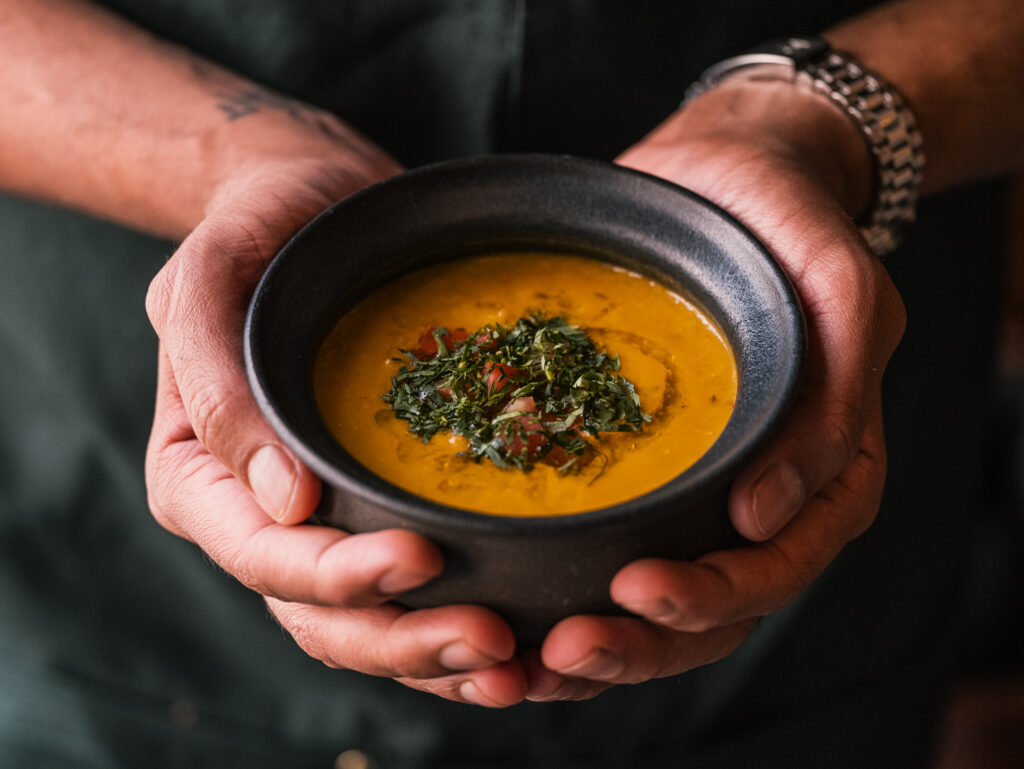
To make it we use red split lentils, which is the kind of dhal you’d make on an everyday basis, because there’s no real soaking needed for it, and it boils within 15 to 20 minutes. So no pressure cooker.
We cook the lentils in water with turmeric, a little red chilli powder and a couple of cloves of garlic. This helps give it a soft, rounded garlic flavor, instead of a harsh one. That’s brought to the boil and simmers for 15 minutes or so until the lentils are falling apart. Then we make a tempering by heating up a good quality grass-fed ghee. A good ghee should taste almost like brown butter, it has that nutty note to it, but without the heaviness. Asafoetida and finely chopped garlic is added to the ghee and cooked until it almost looks burnt, to get that intensity and caramel notes. Then we add onions, loads of ginger and cumin seeds, which is the main spice element.
Mix that temper all together and add the dhal on top. Then right at the end, just before serving, garnish it with a little more hot ghee, chopped coriander and chopped tomatoes. That tomato in its raw form will give freshness to the finished dish.
Lastly, depending on the time of year, we might add lemon juice. In the summer months, that hit of citrus will give it additional freshness. In the winter we’d instead add more ginger to give additional warmth.
What is the first recipe you remember following?
I was exposed to cooking at such a young age that I was already in the kitchen at three years old. Peeling potatoes or doing other hands-on tasks. One of the first recipes I remember actually following was prawn, pea and mint risotto from Giorgio Locatelli’s Made In Italy cookbook.
“When I worked at Locatelli’s restaurant, what really stood out to me wasn’t so much the dishes themselves, but the attention to detail… I still use that technique for the dhal we serve at Bibi, so 18 years later some things don’t change.”
I loved Made In Italy so much that it actually made me want to go and work for Giorgio, which I ended up doing six months later. I cooked every recipe in that book. There were some incredible dishes in there, like the wild rabbit ragu, the prawn linguine and lobster spaghettini. These are all dishes I still cook at home.
When I worked at Locatelli’s restaurant, what really stood out to me wasn’t so much the dishes themselves but the attention to detail. There was a tomato concasse we’d prepare by scoring San Marzano tomatoes, blanching and peeling them, removing the hearts and making diamonds with the flesh of the tomato. I remember doing that prep on the cold section for hours, getting it ready for a lobster dish. I still use that technique for the dhal we serve at Bibi, 18 years later.
Italian food was such a gateway for the way people cook now, or the way that we talk about food. For my generation, watching Italian chefs like Gennaro Contaldo and Locatelli or shows like the Naked Chef, it made cooking cool and feel like it could be quite sexy. It didn’t need to be stuffy, and French, and traditionalist. I think Giorgio was such an interesting character in that sense, because he had done the traditional French route and his brigade is still run like a French kitchen, but he brings this Italian flair and passion to everything that he does.
In a sense this is something I would like to emulate at Bibi. I want young British Asian chefs to be able to come into this restaurant and understand Indian food and Indian flavors but also learn techniques and be open-minded.
What is the recipe you’ve made the most?
It really depends on the context. An omelette or scrambled eggs is probably the real answer to that question. If it’s what I cook for friends, the thing they always ask me to make is chocolate fondant, which is based on an old Heston Blumenthal recipe. At home, my wife asks me to cook biryani most often. I like to think that’s because I can make a good one, but it’s also because my wife loves carbs! There’s a little meat and loads of rice, it makes her very, very happy.
When I talk about biryani I usually mean the version using a cooking style called dum pukht. Dum pukht refers to cooking under a lid in a sealed pot. You’re basically steaming and sautéing at the same time. There is also the South Indian biryani which is completely different and is effectively rice and curry tossed in a pan and mixed up together.
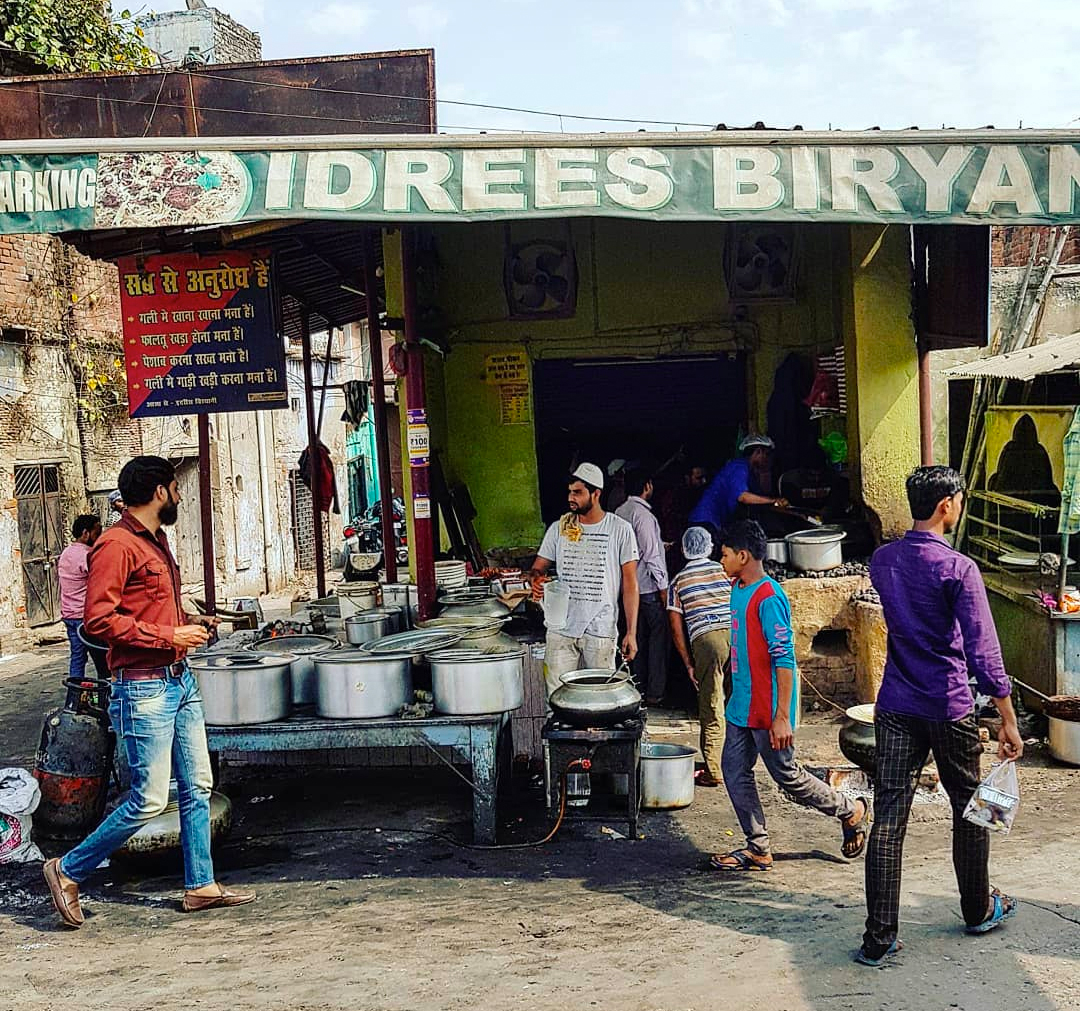
With the dum pukht method, there are two main schools of thought. The Lucknowi version, which is the one I make most often, involves cooking the meat base, layering it with rice then cooking it under a sealed lid. Some people will argue that that’s not a biryani, and technically they’re probably right. Then there’s the Hyderabadi version, from the south central part of India. This version is a little spicier, but the main difference is that everything’s cooked from raw. This method is much more difficult and has a far higher chance of failure. You also don’t know if the meat or rice has actually cooked properly until you crack that lid.
For my Lucknowi biryani I use lots of mint, yellow kashmiri powder, saffron, rose water, ghee, a little milk and pandan leaf water, which has a fragrance similar to jasmine rice. Yellow kashmiri chilli is a little fruitier than its red counterpart and has a gentler finish. In terms of meat, I’d most commonly use goat shoulder or goat neck on the bone. Goat is a lovely meat to put in a biryani and is very traditional for that part of India. That goat has to be cooked with lots of onions, ginger, garlic, ghee and a garam masala rich in earthy spice like black cardamom for at least six hours before even cooking the biryani otherwise it’s never going to be tender. Cooking on the bone is also important and, yes, it does make it more fiddly to eat, but it brings so much flavor and moistness into the entire dish.
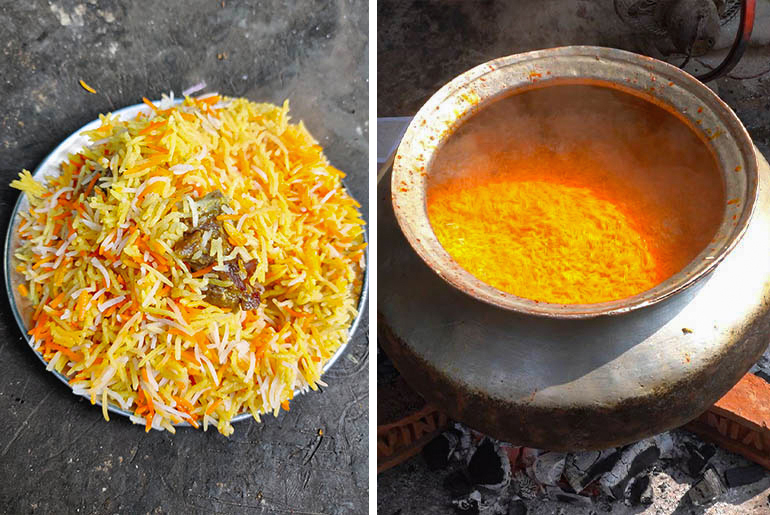
It’s rich and heavy, which is one of the reasons why we wouldn’t serve it at the restaurant, but it’s a very gratifying and enjoyable dish to have with a bowl of yogurt or raita on the side.
Who are the cooks or chefs whose recipes have inspired you?
There are plenty of great cookbook authors out there. Arto der Haroutunian is one of them; he wrote a dozen great books on middle eastern cuisine. There’s a writer named Pushpesh Pant, who writes about Indian food history; not necessarily recipes but about the history of food. K. T. Achaya as well, who has written the Compendium of Indian Food and another titled the History of Indian Food, a book which takes the reader through 10,000 years of history to take us up to this point. Both are fascinating reads.
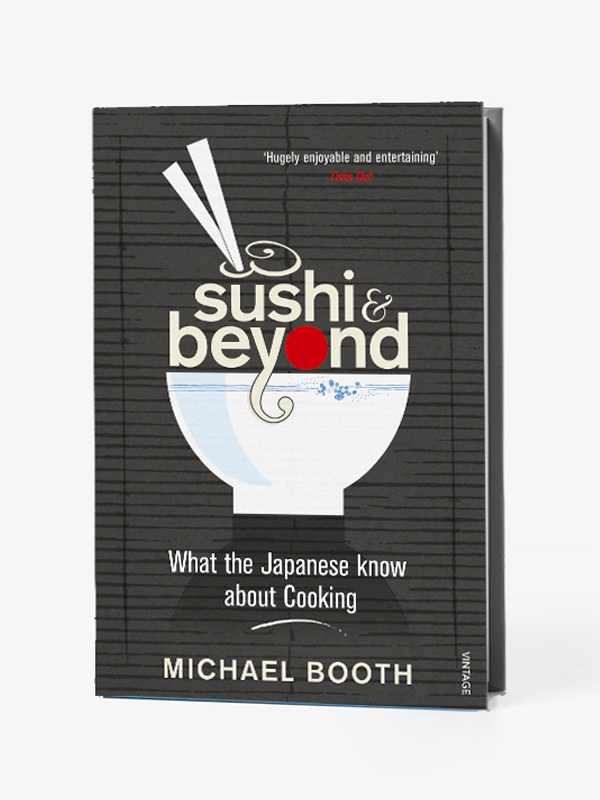
But there’s one person who particularly stands out. I think maybe it’s because I love travelling, I find it really enriching and a great way to be creative. That writer is Michael Booth. He’s a food travel writer, not a chef. He has written a book about his time in India anda few books about his travels through Japan, centred around the food, which I think are incredibly inspiring without necessarily being recipes.
In terms of cooks or chefs that have inspired me, I’d say David Chang. What he managed to do from 2006 and 2017 onwards was quite incredible. Opening his first Momofuku during the recession in New York, really pioneering the no reservation system and the idea that a place does just one dish incredibly well, like they do in Asia. And then slowly building an empire off the back of that. He is also a Korean-American, doing Korean-American food, taking a really new look at this style of cooking and doing it in a confident way. That’s quite inspiring as a British Indian trying to look at Indian food through a modern lens.
He suffers from bipolar, which he talks about frequently in his memoirs, and for him to achieve what he has, in business and as a personality despite those difficulties is really inspiring.
What is the recipe you would hand down to your family?
That would have to be Sharmaji’s Lahori Chicken. Sharmaji is my grandfather, and as I mentioned before, he was part of the generation that saw the partition of India and Pakistan. As a result, he would never ever speak about his background in Pakistan or his time there; it was a really painful period for people on both sides. He didn’t see his dad for two years because they got split up and they ended up at different refugee camps in India before eventually finding each other.
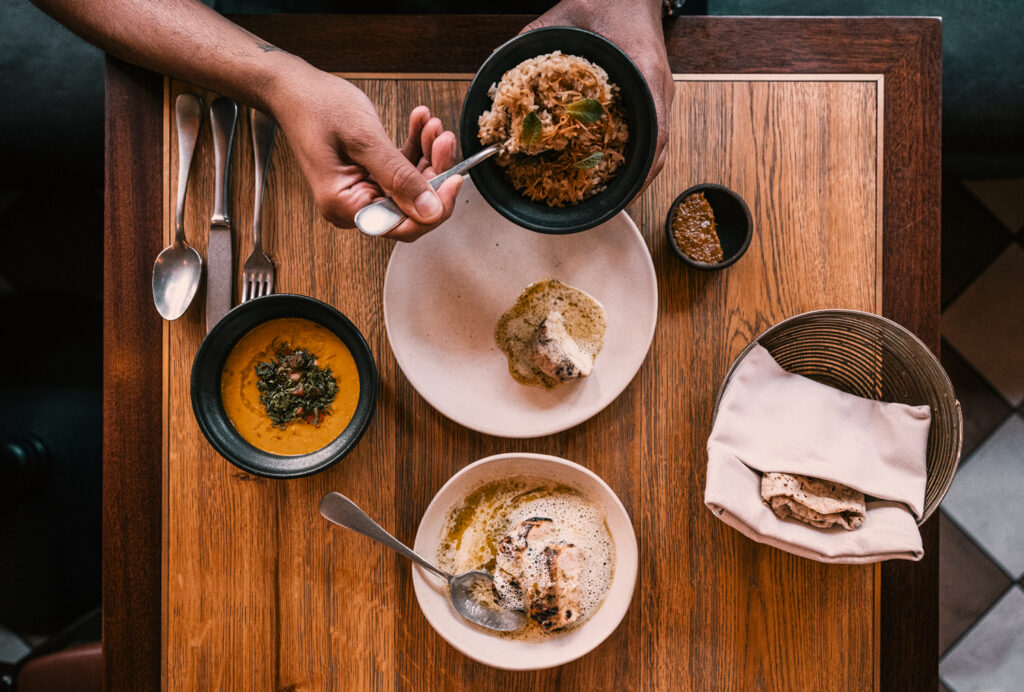
But one thing he would talk about from his time before the partition was this chicken kebab that this local kebab vendor used to make. He would describe some of the flavors and ingredients and they would include cashew, yogurt and this fenugreek spiced tart masala.
I spent a long time working on this dish, basing the recipe off his memories. Sadly he passed away before I had the chance to cook it for him, but we made this dish as homage to him and it’s now a signature dish at our restaurant. I can’t imagine it ever coming off the menu.
We start the process by hanging a natural yogurt in a fridge overnight. The yogurt is relatively low fat but has the necessary acidity to help cut through the richness of the dish, as well as break down and tenderise the meat.
“It’s fair to say that Indians rival the French for their love of butter, so you’re looking at around 50g of butter in this dish.”
The next day we take that whey, which is the draining liquid from the hung yogurt, and put it into a pan along with washed unpeeled ginger, whipping cream and some slightly salted dry roasted cashew nuts. Those cashews act as a thickening agent and bring a gentle sweetness that helps balance the dish. That sauce is cooked slowly until the cashews are soft enough to mash. The cardamom pods are then removed and the sauce is blended until you get the consistency of double cream. Finally, we stir through some ginger and coriander stems cooked down in butter. That coriander stem gives both flavor and bite to the finished sauce.
We then marinate 80 day-old chicken breast with a two-step marinade. That’s something you’ll see quite frequently in Indian cooking. We make the first marinade by mixing together garlic paste, ginger paste, lemon juice and salt. Rub this into the chicken, making sure it is evenly coated, then leave it to marinate for ten minutes.
The second marinade is made with the hung yogurt, smoked mustard oil and a garam masala spice blend. That blend is made by lightly toasting then grinding down green cardamom, black cardamom, cinnamon, mace, rose petals, shahi jeera, cumin seeds, black peppercorns, ground ginger, nutmeg, stone flower, coriander seeds and fennel seeds. With this marinade you really want to work it into the chicken, using your hands. It’s a very physical process.
That chicken is left in the refrigerator for a good few hours then added to metal skewers and cooked over charcoal. The flavor that charcoal gives is really important in a dish like this. There is a fine line between charring and burning the meat, but you really want to take it to the edge, getting the beautiful black edges on the flesh.
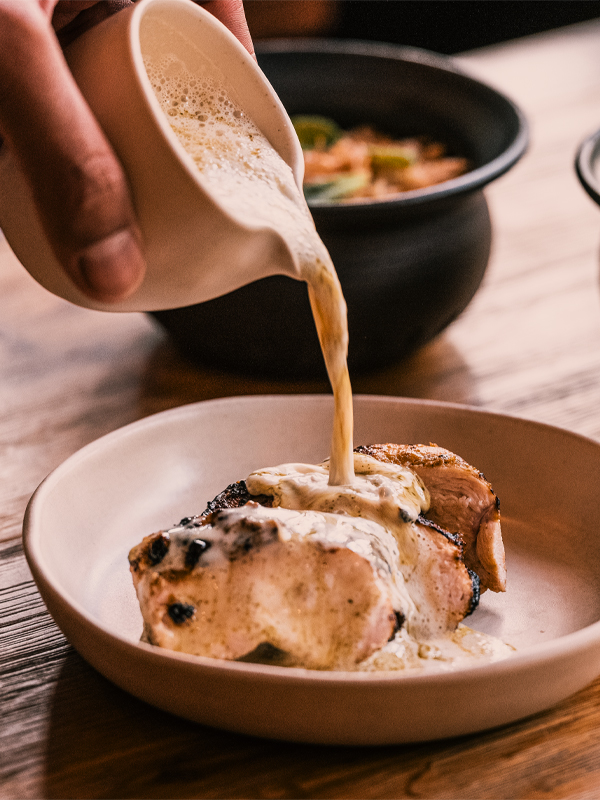
The chicken is cut into thick slices before we add the sauce on top. It’s not a curry, so we don’t drown the chicken in that sauce. You just want to make sure all the chicken is coated nicely.
In terms of finishing the dish, we top with salted butter aged in its own whey, which makes it both very salty and sour. It’s fair to say that Indians rival the French for their love of butter, so you’re looking at around 50g of butter in this dish. Then finally a dusting of a masala, made of mango powder, fenugreek leaves, amchur powder, our white chaat masala, salt and dried mint.
This adds a finishing touch of seasoning, like flaky salt over a steak, but also acidic freshness from the green mango. Of course, fenugreek is bitter and earthy but when applied in small quantities just as we finish the cooking, it gives you a much more rounded and mellow vegetal bitterness.
From both the marinade and getting the cooking right, you should get a beautifully tender chicken. It’s quite a subtle dish, but creamy and rich with just enough acidity to keep you coming back. Like a hug in a bowl.
This is a dish I love, not just because of the history it explores and its flavors, but also because it follows a zero wastage philosophy. From utilising the trims of the chicken in other dishes through to using the whey from the yogurt to make the sauce.
What is a dish on your current menu that represents your approach to cooking?
We have an alphonso mango dish that’s so seasonal it’s only on the menu for three to four weeks.
Alphonso mango is an amazing ingredient grown in Maharashtra and Gujarat, in the western states of India, throughout spring. It’s a super aromatic fruit, named after Afonso de Albuquerque, a portuguese prince who fell in love with India and introduced agricultural techniques to the region.
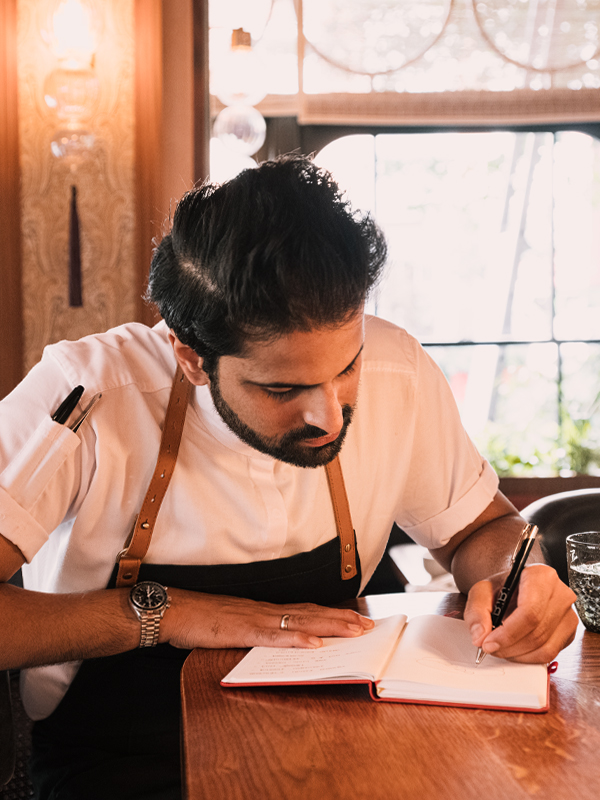
The dish on the menu is actually called an Alphonso Mango Lassi, which is a bit of a ‘fuck you’ to everybody that comes to the restaurant and asks for a mango lassi. I always say you wouldn’t go to the Clove Club and ask for a smoothie before you start your meal, so why would you ask for a lassi in an Indian restaurant? That’s not how we eat in India, it’s very much a curry house mentality we need to get rid of.
The dish uses several preparations of mango and starts with some raw diced alphonso mango, a little cucumber compressed in apple juice and a little bit of borage, which has a flavor not too dissimilar to Pimms, and a mango and yogurt coulis.
We then top that with what we call a Sabudana in Hindi, which is effectively a tapioca pudding. Tapioca is cooked in coconut cream, yogurt and some really lovely vanilla beans from Kerala. This vanilla we use is actually quite spicy, almost savory rather than sweet, and we lean into that by smoking it on our grill over the course of a service. When we open them up they’re really meaty and spicy, and not what you would think of as traditional vanilla, but they still have enough of those top notes of vanilla to keep it in the realm of sweet. We also add a generous amount of sea salt to the tapioca to counteract the sweetness and sneak a bit of Malibu to bring it back from pure sugar sweetness.
Alphonso mango sorbet is placed on top of the Sabudana. The sorbet has a little cardamon running through it, just to evoke that memory of mango lassi.
To finish the dessert, we make these little meringues topped with freeze dried yogurt powder, which give the meringues this real bright burst of acidity. We also have a mango kombucha, which sounds like a long process, but we take all the trimmings from the mango and ferment them with kombucha, so it becomes quite vinegary, but still has a mango flavor to it. That’s turned into a gel, then we dot those around the meringues. Finally, we place flowers all over it, to make it clear that spring is finally here.
I love the seasonality of this dish, it’s creative, different and very of-the-moment. It celebrates an ingredient that we all know and love, but is still unique enough to not be found anywhere else.

Adriana Cavita
LONDON, UK
"I need to balance traditional preparation with modern techniques. I can use traditional recipes as the basis of my creations, but I must also tap into my imagination and passion to create something new and unique."

Rafael Cagali
LONDON / SAO PAULO
"Opening Da Terra was a reconnection to my own origins. I felt lost in a way. The name Da Terra means from the earth, the idea being not to forget what you come from. I like to think that I’m still exploring Brazilian cooking."

Chris Leach
LONDON, UK
"There are quite a lot of recipes I’m proud of, but there are a few that I feel are genuinely original to me. My pig skin ragu recipe is one of those. There is no meat, or rather, flesh, in the dish; it's made from just pig’s skin."

Andrew Clarke
LONDON, UK
"My mum didn't care I was a professional cook. She was going to cook what she wanted to cook, and love what she was doing. And there’s an honesty and beauty to that."




